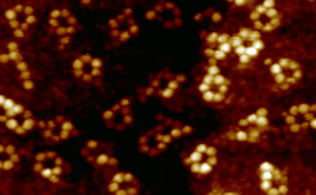Scientists’ report world’s first X-ray of a single atom
Scientists have now achieved what was once considered to be almost unattainable: X-raying a single atom.

[June 1, 2023: Staff Writer, The Brighter Side of News]
Supramolecular assemblies of six rubidium and one iron atom. Scanning tunneling microscopy revealed the clear signal of the one iron atom. (CREDIT: Ajayi et al.)
Scientists have now achieved what was once considered to be almost unattainable: X-raying a single atom. This extraordinary accomplishment was made possible by an international team of researchers led by Saw Wai Hla, Professor of Physics at Ohio University and scientist at Argonne National Laboratory.
For over a century since Wilhelm Roentgen's groundbreaking discovery in 1895, X-ray technology has been instrumental in various fields – from medical diagnostics to space explorations and even everyday security checks.
The main use of X-rays in the scientific world is in determining the type of materials present in a given sample. However, the minimum quantity of material required for X-ray detection has been considerably reduced thanks to the advent of synchrotron X-ray sources and innovative instruments.
Previously, the smallest amount one could X-ray was an attogram, which equates to approximately 10,000 atoms or more. This limitation was due to the extraordinarily faint X-ray signal emitted by an individual atom, too weak to be detected by traditional X-ray detectors. This ambitious goal of X-raying a single atom has now been achieved by Professor Hla's team, fulfilling a long-held dream of the scientific community.
Related Stories
“Atoms can be routinely imaged with scanning probe microscopes, but without X-rays one cannot tell what they are made of. We can now detect exactly the type of a particular atom, one atom-at-a-time, and can simultaneously measure its chemical state,” explained Hla, who is also the director of the Nanoscale and Quantum Phenomena Institute at Ohio University. “Once we are able to do that, we can trace the materials down to ultimate limit of just one atom.”
Published in the renowned scientific journal Nature, their study outlined how this groundbreaking feat was achieved. The research was conducted using a specially designed synchrotron X-ray instrument located at the XTIP beamline of the Advanced Photon Source and the Center for Nanoscale Materials at Argonne National Laboratory.
The team's approach involved choosing an iron atom and a terbium atom, each positioned within their respective molecular hosts. They enhanced conventional X-ray detectors by incorporating a unique detector comprising a sharp metal tip situated extremely close to the sample. This method, called synchrotron X-ray scanning tunneling microscopy (SX-STM), enabled the collection of X-ray excited electrons. This innovative technique allows for the identification of the elemental type of materials directly.
(Left) An image of a ring shaped supramolecule where only one Fe atom is present in the entire ring. (Right) X-ray signature of just one Fe atom. (CREDIT: Saw-Wai Hla)
Tolulope Michael Ajayi, first author of the paper and a Ph.D. candidate involved in the research, emphasized the groundbreaking nature of this study. "This technique broke new ground in X-ray science and nanoscale studies. Using X-rays to detect and characterize individual atoms could revolutionize research, leading to novel technologies in quantum information, trace element detection in environmental and medical research, and advanced material science instrumentation," Ajayi said.
Over the past 12 years, Hla has been intricately involved in the development of the SX-STM instrument and its measurement methods alongside Volker Rose, a scientist at the Advanced Photon Source at Argonne National Laboratory. "We have come a long way to achieve the detection of a single atom X-ray signature," Hla said.
When X-rays (blue color) illuminate onto an iron atom (red ball at the center of the molecule), core level electrons are excited. X-ray excited electrons are then tunnel to the detector tip (gray) via overlapping atomic/molecular orbitals, which provide elemental and chemical information of the iron atom. (CREDIT: Saw-Wai Hla)
This study is a giant leap forward in the field of nano and quantum sciences, focusing on understanding the chemical and physical properties of materials at the fundamental level - on an individual atom basis. Through this discovery, scientists can now not only identify the elemental type of an atom but also its chemical state, potentially revolutionizing the field of material science.
Professor Hla and his team of researchers are committed to further exploring the potential of this breakthrough discovery. Their aim is to continue to use X-rays to detect properties of single atoms, aiming to revolutionize applications for material research and beyond.
Saw-Wai Hla. (CREDIT: Ohio University)
Their research could very well redefine our understanding of the atomic world, leading to unprecedented developments in science and technology. This landmark achievement in X-ray technology heralds an exciting new era in scientific research.
As Professor Hla concluded, "this will have a great impact on environmental and medical sciences and maybe even find a cure that can have a huge impact for humankind. This discovery will transform the world."
For more science and technology news stories check out our New Discoveries section at The Brighter Side of News.
Note: Materials provided above by The Brighter Side of News. Content may be edited for style and length.
Like these kind of feel good stories? Get the Brighter Side of News' newsletter.
Joseph Shavit
Head Science News Writer | Communicating Innovation & Discovery
Based in Los Angeles, Joseph Shavit is an accomplished science journalist, head science news writer and co-founder at The Brighter Side of News, where he translates cutting-edge discoveries into compelling stories for a broad audience. With a strong background spanning science, business, product management, media leadership, and entrepreneurship, Joseph brings a unique perspective to science communication. His expertise allows him to uncover the intersection of technological advancements and market potential, shedding light on how groundbreaking research evolves into transformative products and industries.



